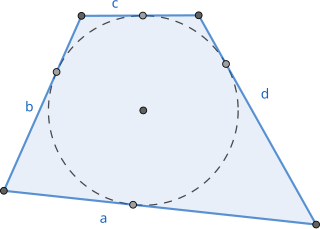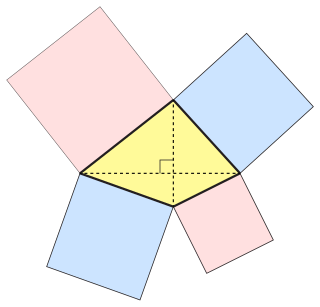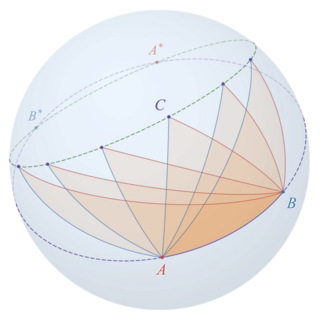
Theorem of the Gnomon: green area = red area,
The theorem of the gnomon states that certain parallelograms occurring in a gnomon have areas of equal size.

The theorem of the gnomon states that certain parallelograms occurring in a gnomon have areas of equal size.
In a parallelogram with a point on the diagonal , the parallel to through intersects the side in and the side in . Similarly the parallel to the side through intersects the side in and the side in . Then the theorem of the gnomon states that the parallelograms and have equal areas. [1] [2]
Gnomon is the name for the L-shaped figure consisting of the two overlapping parallelograms and . The parallelograms of equal area and are called complements (of the parallelograms on diagonal and ). [3]
The proof of the theorem is straightforward if one considers the areas of the main parallelogram and the two inner parallelograms around its diagonal:


The theorem of the gnomon can be used to construct a new parallelogram or rectangle of equal area to a given parallelogram or rectangle by the means of straightedge and compass constructions. This also allows the representation of a division of two numbers in geometrical terms, an important feature to reformulate geometrical problems in algebraic terms. More precisely, if two numbers are given as lengths of line segments one can construct a third line segment, the length of which matches the quotient of those two numbers (see diagram). Another application is to transfer the ratio of partition of one line segment to another line segment (of different length), thus dividing that other line segment in the same ratio as a given line segment and its partition (see diagram). [1]

A similar statement can be made in three dimensions for parallelepipeds. In this case you have a point on the space diagonal of a parallelepiped, and instead of two parallel lines you have three planes through , each parallel to the faces of the parallelepiped. The three planes partition the parallelepiped into eight smaller parallelepipeds; two of those surround the diagonal and meet at . Now each of those two parallelepipeds around the diagonal has three of the remaining six parallelepipeds attached to it, and those three play the role of the complements and are of equal volume (see diagram). [2]

The theorem of gnomon is special case of a more general statement about nested parallelograms with a common diagonal. For a given parallelogram consider an arbitrary inner parallelogram having as a diagonal as well. Furthermore there are two uniquely determined parallelograms and the sides of which are parallel to the sides of the outer parallelogram and which share the vertex with the inner parallelogram. Now the difference of the areas of those two parallelograms is equal to area of the inner parallelogram, that is: [2]
This statement yields the theorem of the gnomon if one looks at a degenerate inner parallelogram whose vertices are all on the diagonal . This means in particular for the parallelograms and , that their common point is on the diagonal and that the difference of their areas is zero, which is exactly what the theorem of the gnomon states.
The theorem of the gnomon was described as early as in Euclid's Elements (around 300 BC), and there it plays an important role in the derivation of other theorems. It is given as proposition 43 in Book I of the Elements, where it is phrased as a statement about parallelograms without using the term "gnomon". The latter is introduced by Euclid as the second definition of the second book of Elements. Further theorems for which the gnomon and its properties play an important role are proposition 6 in Book II, proposition 29 in Book VI and propositions 1 to 4 in Book XIII. [5] [4] [6]

In geometry a quadrilateral is a four-sided polygon, having four edges (sides) and four corners (vertices). The word is derived from the Latin words quadri, a variant of four, and latus, meaning "side". It is also called a tetragon, derived from Greek "tetra" meaning "four" and "gon" meaning "corner" or "angle", in analogy to other polygons. Since "gon" means "angle", it is analogously called a quadrangle, or 4-angle. A quadrilateral with vertices , , and is sometimes denoted as .

In Euclidean geometry, a parallelogram is a simple (non-self-intersecting) quadrilateral with two pairs of parallel sides. The opposite or facing sides of a parallelogram are of equal length and the opposite angles of a parallelogram are of equal measure. The congruence of opposite sides and opposite angles is a direct consequence of the Euclidean parallel postulate and neither condition can be proven without appealing to the Euclidean parallel postulate or one of its equivalent formulations.

In plane Euclidean geometry, a rhombus is a quadrilateral whose four sides all have the same length. Another name is equilateral quadrilateral, since equilateral means that all of its sides are equal in length. The rhombus is often called a "diamond", after the diamonds suit in playing cards which resembles the projection of an octahedral diamond, or a lozenge, though the former sometimes refers specifically to a rhombus with a 60° angle, and the latter sometimes refers specifically to a rhombus with a 45° angle.

In Euclidean geometry, a cyclic quadrilateral or inscribed quadrilateral is a quadrilateral whose vertices all lie on a single circle. This circle is called the circumcircle or circumscribed circle, and the vertices are said to be concyclic. The center of the circle and its radius are called the circumcenter and the circumradius respectively. Other names for these quadrilaterals are concyclic quadrilateral and chordal quadrilateral, the latter since the sides of the quadrilateral are chords of the circumcircle. Usually the quadrilateral is assumed to be convex, but there are also crossed cyclic quadrilaterals. The formulas and properties given below are valid in the convex case.

In geometry, a trapezoid in USA and Canadian English, or trapezium in British and other forms of English, is a quadrilateral that has at least one pair of parallel sides.

In geometry, Thales's theorem states that if A, B, and C are distinct points on a circle where the line AC is a diameter, the angle ∠ ABC is a right angle. Thales's theorem is a special case of the inscribed angle theorem and is mentioned and proved as part of the 31st proposition in the third book of Euclid's Elements. It is generally attributed to Thales of Miletus, but it is sometimes attributed to Pythagoras.

In Euclidean geometry, a square is a regular quadrilateral, which means that it has four equal sides and four equal angles. It can also be defined as a rectangle with two equal-length adjacent sides. It is the only regular polygon whose internal angle, central angle, and external angle are all equal (90°), and whose diagonals are all equal in length. A square with vertices ABCD would be denoted ABCD.

In geometry, the statement that the angles opposite the equal sides of an isosceles triangle are themselves equal is known as the pons asinorum, typically translated as "bridge of asses". This statement is Proposition 5 of Book 1 in Euclid's Elements, and is also known as the isosceles triangle theorem. Its converse is also true: if two angles of a triangle are equal, then the sides opposite them are also equal. The term is also applied to the Pythagorean theorem.

In Euclidean geometry, the British flag theorem says that if a point P is chosen inside a rectangle ABCD then the sum of the squares of the Euclidean distances from P to two opposite corners of the rectangle equals the sum to the other two opposite corners. As an equation:

In Euclidean geometry, a tangential quadrilateral or circumscribed quadrilateral is a convex quadrilateral whose sides all can be tangent to a single circle within the quadrilateral. This circle is called the incircle of the quadrilateral or its inscribed circle, its center is the incenter and its radius is called the inradius. Since these quadrilaterals can be drawn surrounding or circumscribing their incircles, they have also been called circumscribable quadrilaterals, circumscribing quadrilaterals, and circumscriptible quadrilaterals. Tangential quadrilaterals are a special case of tangential polygons.
The intercept theorem, also known as Thales's theorem, basic proportionality theorem or side splitter theorem is an important theorem in elementary geometry about the ratios of various line segments that are created if two rays with a common starting point are intercepted by a pair of parallels. It is equivalent to the theorem about ratios in similar triangles. It is traditionally attributed to Greek mathematician Thales. It was known to the ancient Babylonians and Egyptians, although its first known proof appears in Euclid's Elements.

In Euclidean geometry, Varignon's theorem holds that the midpoints of the sides of an arbitrary quadrilateral form a parallelogram, called the Varignon parallelogram. It is named after Pierre Varignon, whose proof was published posthumously in 1731.

In mathematics, the Pythagorean theorem or Pythagoras' theorem is a fundamental relation in Euclidean geometry between the three sides of a right triangle. It states that the area of the square whose side is the hypotenuse is equal to the sum of the areas of the squares on the other two sides.

In Euclidean geometry, an orthodiagonal quadrilateral is a quadrilateral in which the diagonals cross at right angles. In other words, it is a four-sided figure in which the line segments between non-adjacent vertices are orthogonal (perpendicular) to each other.

In Euclidean geometry, an ex-tangential quadrilateral is a convex quadrilateral where the extensions of all four sides are tangent to a circle outside the quadrilateral. It has also been called an exscriptible quadrilateral. The circle is called its excircle, its radius the exradius and its center the excenter. The excenter lies at the intersection of six angle bisectors. These are the internal angle bisectors at two opposite vertex angles, the external angle bisectors at the other two vertex angles, and the external angle bisectors at the angles formed where the extensions of opposite sides intersect. The ex-tangential quadrilateral is closely related to the tangential quadrilateral.

The quadratrix or trisectrix of Hippias is a curve which is created by a uniform motion. It is one of the oldest examples for a kinematic curve. Its discovery is attributed to the Greek sophist Hippias of Elis, who used it around 420 BC in an attempt to solve the angle trisection problem. Later around 350 BC Dinostratus used it in an attempt to solve the problem of squaring the circle.
In Euclidean geometry, Anne's theorem describes an equality of certain areas within a convex quadrilateral. This theorem is named after the French mathematician Pierre-Leon Anne (1806–1850).

Pappus's area theorem describes the relationship between the areas of three parallelograms attached to three sides of an arbitrary triangle. The theorem, which can also be thought of as a generalization of the Pythagorean theorem, is named after the Greek mathematician Pappus of Alexandria, who discovered it.

Euler's quadrilateral theorem or Euler's law on quadrilaterals, named after Leonhard Euler (1707–1783), describes a relation between the sides of a convex quadrilateral and its diagonals. It is a generalisation of the parallelogram law which in turn can be seen as generalisation of the Pythagorean theorem. Because of the latter the restatement of the Pythagorean theorem in terms of quadrilaterals is occasionally called the Euler–Pythagoras theorem.

In spherical geometry, Lexell's theorem holds that every spherical triangle with the same surface area on a fixed base has its apex on a small circle, called Lexell's circle or Lexell's locus, passing through two points antipodal to the two base vertices.